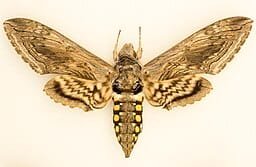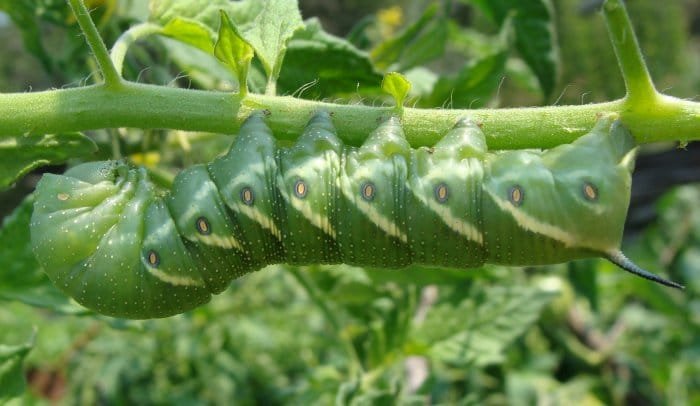What are Tomato Hornworms?
Tomato hornworms are large caterpillars that pose a significant threat to the nightshade family, mainly tomato and pepper plants. These green pests can grow up to 4 inches long and are the larvae of the five-spotted hawk moth. They feed voraciously on the leaves, stems, and fruits of tomato and pepper plants (sometimes eggplants and potato plants too), stripping the plants bare if left unchecked.
How to Spot Tomato Hornworms
Identifying tomato hornworms is crucial for timely intervention. Look for these tell-tale signs: leaves that have been eaten away with only the stems remaining, pellet-like droppings on the ground, or the hornworms themselves, which have a distinctive horn-like projection on their rear. Their excellent camouflage makes them blend in with the plants, so regular inspections are necessary to catch them early.
Another method to find tomato hornworms is search for them after dark. To do so, you’ll need a black (UV emitting) light. Then you walk around your tomato and pepper plants and shine the light over all leaves, stems, and fruits. If a hornworm is on the plant, it’ll glow under the black light. Then you pick it off and dispose of it.
Are Hornworms Dangerous?
No. The horn-like spike is all for show, and it can’t sting you. It also doesn’t bite or carry diseases. They are quite strong for a caterpillar though. Often, it takes a good tug to remove them from the plant.
Tomato Hornworm Prevention Tips
Preventing tomato hornworm infestations is essential for a thriving garden. Companion plants such as basil and marigolds can help keep them away. Otherwise, if you see signs of damage, start by handpicking any visible hornworms off to effectively keep them at bay. Regularly inspecting your plants and practicing good garden hygiene, such as clearing debris and rotating crops, also greatly aids in prevention.
As for biological control, Bacillus thuringiensis (Bt) is an organic method to kill hornworms, as well as all kinds of other caterpillars. However, please keep in mind it takes spraying the leaves of tomato plants often, and anytime tomato leaves get wet, there’s an increased chance of fungal diseases. We use Bt for caterpillar control on lots of different vegetation but never on nightshades. We simply check our nightshades often for hornworm damage, and one or more are found we pick them off.
Natural Predators of the Hornworm
Attracting beneficial insects like braconid wasps helps. Some birds also eat hornworms too. While natural predators are wonderful, hornworms can decimate a plant quickly, so it’s best to not rely on natural predators and be on the hunt for signs. That way you can minimize the damage immediately.
Five-spotted Hawk Moth

Tomato Hornworm

